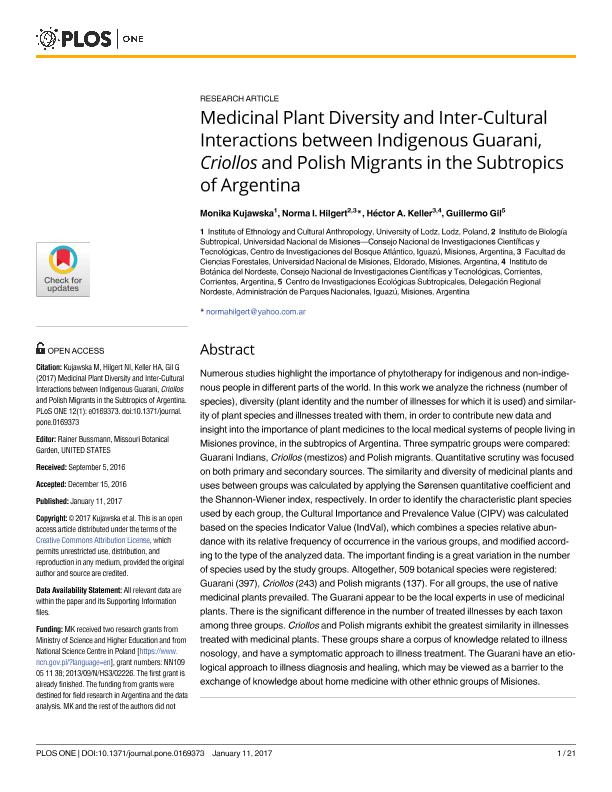Mostrar el registro sencillo del ítem
dc.contributor.author
Kujawska, Monika
dc.contributor.author
Hilgert, Norma Ines

dc.contributor.author
Keller, Hector Alejandro

dc.contributor.author
Gil, Guillermo Pablo

dc.date.available
2018-05-11T20:35:18Z
dc.date.issued
2017-01
dc.identifier.citation
Kujawska, Monika; Hilgert, Norma Ines; Keller, Hector Alejandro; Gil, Guillermo Pablo; Medicinal Plant Diversity and Inter-Cultural Interactions between Indigenous Guarani, Criollos and Polish Migrants in the Subtropics of Argentina; Public Library of Science; Plos One; 12; 1; 1-2017; 1-21
dc.identifier.issn
1932-6203
dc.identifier.uri
http://hdl.handle.net/11336/44987
dc.description.abstract
Numerous studies highlight the importance of phytotherapy for indigenous and non-indigenous people in different parts of the world. In this work we analyze the richness (number of species), diversity (plant identity and the number of illnesses for which it is used) and similarity of plant species and illnesses treated with them, in order to contribute new data and insight into the importance of plant medicines to the local medical systems of people living in Misiones province, in the subtropics of Argentina. Three sympatric groups were compared: Guarani Indians, Criollos (mestizos) and Polish migrants. Quantitative scrutiny was focused on both primary and secondary sources. The similarity and diversity of medicinal plants and uses between groups was calculated by applying the Sørensen quantitative coefficient and the Shannon-Wiener index, respectively. In order to identify the characteristic plant species used by each group, the Cultural Importance and Prevalence Value (CIPV) was calculated based on the species Indicator Value (IndVal), which combines a species relative abundance with its relative frequency of occurrence in the various groups, and modified according to the type of the analyzed data. The important finding is a great variation in the number of species used by the study groups. Altogether, 509 botanical species were registered: Guarani (397), Criollos (243) and Polish migrants (137). For all groups, the use of native medicinal plants prevailed. The Guarani appear to be the local experts in use of medicinal plants. There is the significant difference in the number of treated illnesses by each taxon among three groups. Criollos and Polish migrants exhibit the greatest similarity in illnesses treated with medicinal plants. These groups share a corpus of knowledge related to illness nosology, and have a symptomatic approach to illness treatment. The Guarani have an etiological approach to illness diagnosis and healing, which may be viewed as a barrier to the exchange of knowledge about home medicine with other ethnic groups of Misiones
dc.format
application/pdf
dc.language.iso
eng
dc.publisher
Public Library of Science

dc.rights
info:eu-repo/semantics/openAccess
dc.rights.uri
https://creativecommons.org/licenses/by-nc-sa/2.5/ar/
dc.subject
Traditional Medicine
dc.subject
Guaranis
dc.subject
Polish
dc.subject
Criollos
dc.subject.classification
Otras Ciencias Biológicas

dc.subject.classification
Ciencias Biológicas

dc.subject.classification
CIENCIAS NATURALES Y EXACTAS

dc.title
Medicinal Plant Diversity and Inter-Cultural Interactions between Indigenous Guarani, Criollos and Polish Migrants in the Subtropics of Argentina
dc.type
info:eu-repo/semantics/article
dc.type
info:ar-repo/semantics/artículo
dc.type
info:eu-repo/semantics/publishedVersion
dc.date.updated
2018-05-04T20:16:05Z
dc.identifier.eissn
1932-6203
dc.journal.volume
12
dc.journal.number
1
dc.journal.pagination
1-21
dc.journal.pais
Estados Unidos

dc.journal.ciudad
San Francisco
dc.description.fil
Fil: Kujawska, Monika. Institute Of Ethnology And Cultural, University Of Lodz; Polonia
dc.description.fil
Fil: Hilgert, Norma Ines. Consejo Nacional de Investigaciones Científicas y Técnicas. Centro Científico Tecnológico Conicet - Nordeste. Instituto de Biología Subtropical. Instituto de Biología Subtropical - Nodo Puerto Iguazú | Universidad Nacional de Misiones. Instituto de Biología Subtropical. Instituto de Biología Subtropical - Nodo Puerto Iguazú; Argentina
dc.description.fil
Fil: Keller, Hector Alejandro. Consejo Nacional de Investigaciones Científicas y Técnicas. Centro Científico Tecnológico Conicet - Nordeste. Instituto de Botánica del Nordeste. Universidad Nacional del Nordeste. Facultad de Ciencias Agrarias. Instituto de Botánica del Nordeste; Argentina
dc.description.fil
Fil: Gil, Guillermo Pablo. Administración de Parques Nacionales. Parque Nacional ; Argentina
dc.journal.title
Plos One

dc.relation.alternativeid
info:eu-repo/semantics/altIdentifier/url/http://journals.plos.org/plosone/article?id=10.1371/journal.pone.0169373
dc.relation.alternativeid
info:eu-repo/semantics/altIdentifier/doi/http://dx.doi.org/10.1371/journal.pone.0169373
Archivos asociados
